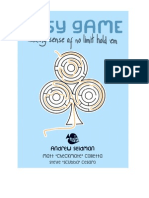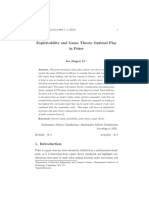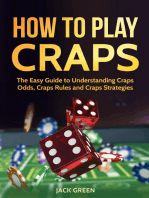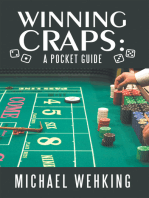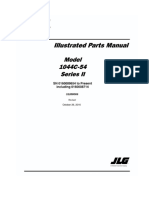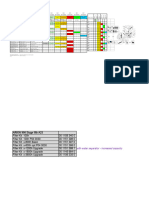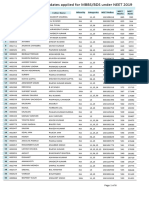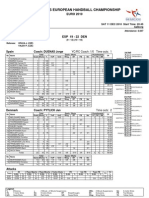RedChipPoker Late Position Chapter 8 PDF
RedChipPoker Late Position Chapter 8 PDF
Uploaded by
Goran StevanovicCopyright:
Available Formats
RedChipPoker Late Position Chapter 8 PDF
RedChipPoker Late Position Chapter 8 PDF
Uploaded by
Goran StevanovicOriginal Title
Copyright
Available Formats
Share this document
Did you find this document useful?
Is this content inappropriate?
Copyright:
Available Formats
RedChipPoker Late Position Chapter 8 PDF
RedChipPoker Late Position Chapter 8 PDF
Uploaded by
Goran StevanovicCopyright:
Available Formats
Red Chip Poker: Late Position
Range Merging with an Overbet
(Villains flaw)
(Difficulty rating)
(Heros exploit)
The idea behind a bluff is that we are not thinking about the value of our
hand but the next level up: Can Villain be convinced his hand is a loser? A
bluff relies on the assumption that Villain will be able to assign enough
better hands to your range and will come to the conclusion that he normally
would lose money by calling your bet.
The next level of thinking is, Can we find spots where Villain will
conclude that we are bluffing and therefore call, even with a weak hand?
Bluff catching is where you call with a weak hand that can only really beat a
bluff. The key is to recognize that Villain will call with bluff catchers, and
then we value bet our hands that slightly beat that range. This implies that
we will be betting a hand that is normally not bet for value within the player
pool.
$2-$5
Taj
MP2
Image:
Action:
Hand:
Thinking TAG
$20/Call
Starting
Stack:
$540
Button
Hero
$65
Covers
If someone were to sit to my left and re-raise me every time I raise
preflop, they would absolutely destroy me. Most of the time I would fold
until I figured it out and adjusted. Likewise, this thinking TAG will often
fold to a three-bet when out of position. The suited Ace we hold gives us
card removal and equity if called. We would have preferred the TAG to
fold, but we can use our skills and position to win this pot post-flop.
What do we think this Villain has? He almost always enters a pot by
raising pre-flop. So, we can assume he would raise hands like pocket pairs
or strong Broadways rather than limp them.
We expect that the TAG would raise our three-bet with KK+ and
sometimes with QQ or AK. However, there is a small but real chance he
would flat call with QQ+ for deception. The stack sizes are not deep
enough to expect him to set mine with small pairs. That puts his raise-call
56
Hands
range at TT+ and AQ+. A good TAG is not likely to call a three-bet out of
position with easily dominated hands like KQ and AJ.
The chart shows those hands he would raise-fold in grey with the raisecall in white. Of the 184 combinations he raises with pre-flop, he will only
continue with 51 of them. This takes into account our hole cards which
block out the Ace and Three. This yields 72% folds pre-flop. When a player
folds this often against our three-bet, and this three-bet size, the play is
outright profitable.
AA
AK
AQ
AJ
AT
A9
A8
A7
A6
A5
A4
A3
A2
AKs
KK
KQ
KJ
KT
K9
K8
K7
K6
K5
K4
K3
K2
TAGs MP2 raise-call range pre-flop
AQs AJs ATs A9s A8s A7s A6s A5s A4s
KQs KJs KTs K9s K8s K7s K6s K5s K4s
QQ QJs QTs Q9s Q8s Q7s Q6s Q5s Q4s
QJ JJ JTs J9s J8s J7s J6s J5s J4s
QT JT TT T9s T8s T7s T6s T5s T4s
Q9 J9 T9 99 98s 97s 96s 95s 94s
Q8 J8 T8 98 88 87s 86s 85s 84s
Q7 J7 T7 97 87 77 76s 75s 74s
Q6 J6 T6 96 86 76 66 65s 64s
Q5 J5 T5 95 85 75 65 55 54s
Q4 J4 T4 94 84 74 64 54 44
Q3 J3 T3 93 83 73 63 53 43
Q2 J2 T2 92 82 72 62 52 42
A3s
K3s
Q3s
J3s
T3s
93s
83s
73s
63s
53s
43s
33
32
A2s
K2s
Q2s
J2s
T2s
92s
82s
72s
62s
52s
42s
32s
22
We see the flop.
Pot: $137
Thinking TAG
Check
Starting
Stack:
$475
Hero
$75
Covers
(MP2)
(Button)
Range:
This is an interesting flop texture. TAG players tend to be much more
straightforward in three-bet pots. They are fit-or-fold in these situations,
which can lead us to think the following:
57
Red Chip Poker: Late Position
He will fold his Ace high hands.
He will not bluff if we continuation bet.
He may semi-bluff raise with Spades or Tens.
He will not raise hands like JJ or QQ.
It is not hard for his range to be ahead of our dreadful hand. Looking
to Flopzilla, his range is ahead of our hand by a healthy 87% versus 13%.
However, let us look at a different statistic in Flopzilla: How many of his
hand combinations hit this board?
AA
AK
AQ
AJ
AT
A9
A8
A7
A6
A5
A4
A3
A2
KK
KQ
KJ
KT
K9
K8
K7
K6
K5
K4
K3
K2
TAGs hits on:
ATs A9s
KTs K9s
QTs Q9s
QJ JJ JTs J9s
QT JT TT T9s
Q9 J9 T9 99
Q8 J8 T8 98
Q7 J7 T7 97
Q6 J6 T6 96
Q5 J5 T5 95
Q4 J4 T4 94
Q3 J3 T3 93
Q2 J2 T2 92
A8s
K8s
Q8s
J8s
T8s
98s
88
87
86
85
84
83
82
A7s
K7s
Q7s
J7s
T7s
97s
87s
77
76
75
74
73
72
(45% hits)
A6s A5s A4s
K6s K5s K4s
Q6s Q5s Q4s
J6s J5s J4s
T6s T5s T4s
96s 95s 94s
86s 85s 84s
76s 75s 74s
66 65s 64s
65 55 54s
64 54 44
63 53 43
62 52 42
A3s
K3s
Q3s
J3s
T3s
93s
83s
73s
63s
53s
43s
33
32
A2s
K2s
Q2s
J2s
T2s
92s
82s
72s
62s
52s
42s
32s
22
There is plenty for him to fold on this board. Much of his range, 55%,
is an unhappy AQ or AK without Spades. We bet just over half pot on the
flop. He is not going to be price-sensitive. If we are trying to buy a fold, we
might as well go smaller than the typical 2/3 pot-sized bet. A half-pot sized
bet only needs to work 1/3 of the time to break even. This makes our
continuation bet profitable.
Some actions reduce, but do not eliminate, certain holdings from a
range. This is called discounting. If we think Villain would sometimes do
something, we might only count 75% of the combinations. This would be
called a 25% discount When he only calls, we can discount some of those
slowplayed KK+ combos. His calling range looks to be TT-QQ and AQ+
of Spades. We cannot know with what frequency he would check-raise with
58
Hands
TT, Spades or even KK+. In this hand, we assume he will check-raise TT
and Spades 50% of the time and KK+ 75% of the time. This is important
when factoring weighted combinations into an entire range.
Pot: $287
Thinking TAG
Check
Starting
Stack:
$400
Hero
Check
Covers
(MP2)
(Button)
Range:
There are not a lot of Sixes for either of us to have, so the open-ended
straight draw that filled is not much of a concern for either person. One
thing to consider is how we would play the turn with AA. If we bet with
AA here, is he going to continue with TT+? By betting AA it is difficult to
get value from those worse hands; which would lead us to check the turn
behind more often. This turn is usually going to go check-check.
Versus a thinking player we need to consider what range he would put
us on. If we bet this turn we represent a range that has rare 6x and a
disproportionate amount of bluffs. This would make it easy for our
opponent to react against our bet.
In this exact situation we could actually check most of our range
behind, both bluffs like A3 and value hands like AA. The check in this
exact instance is giving up. But there are times when we will have AA here,
check behind on the turn, and not give up on every river.
Pot: $287
Thinking TAG
Check
Starting
Stack:
$400
Hero
???
Covers
(MP2)
(Button)
Range:
We love the Ace, but our work here is not done. We still have to think
about the TAGs range once he checks to us. When he gets to the river, his
range looks like this:
59
Red Chip Poker: Late Position
,
50%
discount
0% discount
3 combos
12 combos
,
75% discount
50%
discount
1.5 combos
1 combo
(Added to pre-flop KK+
discount)
Now we have to ask ourselves a few questions:
Would he bet the river with AA?
Would he bet the river with AK or AQ of Spades?
Would he bet the river with TT+?
How would he react to any bets or sizes with worse hands?
We can expect a TAG to bet this river if he improved to top set. This
means we can discount AA altogether when he checks. We can likely
discount AK and AQ of Spades, thinking he would bet a strong top pair
once the turn goes check-check.
The other question is, How he would react with the now-second pair
range of TT-KK? It is logical to assume a TAG would treat these hands as
having showdown value and check the river. Some of these combinations
are already discounted given the flop action, but there are still a full 12
combinations of JJ-QQ. These pairs represent a large proportion of his
river checking range that we need to consider before making our river
decision.
Now that we know his range once he checks the river, we have to
figure out if we can value bet. Because the TAG is a thinking player, we
need to consider how he would view a bet. In his games, he is likely used to
seeing players check back with an Ace on these board textures. So a bet
with a single pair on a 4-straight and missed flush board would be a rarity
for him to see, further discounting him putting us on an Ace. If somehow a
player did bet an Ace on the river, the TAG is expecting to see something
close to $175. So if we shove for $400, what does he think we have? Air.
When we make any value bet, we need to represent enough bluffs to
allow our opponent to make mistakes. Oddly enough, we are more likely to
get called by his QQ if we bet $400 than $175, since $175 would rarely be
perceived as a bluff, and $400 looks bluff heavy.
Notice that everything going into this river shove is based upon our
opponents ability to assign ranges, to make assumptions on bet sizing, and
to follow through on his reads in order to call the river with second-best
pairs. Hands like these are not common, but they can provide extra profit.
60
Hands
The better you get at understanding your opponents thought process, and
thought process limitations, the better you will get at exploiting them in
creative ways.
Villain calls and mutters, Nice catch, sir. We all know the translation
of that statement.
61
You might also like
- RedChipPoker Late Position Chapter 2 PDFDocument4 pagesRedChipPoker Late Position Chapter 2 PDFGoran StevanovicNo ratings yet
- RekopDocument106 pagesRekopFelipe OrnellesNo ratings yet
- Do We Barrel The Turn or Check Raise ItDocument3 pagesDo We Barrel The Turn or Check Raise ItMark GregoryNo ratings yet
- RedChipPoker Late Position Chapter 4Document4 pagesRedChipPoker Late Position Chapter 4Goran StevanovicNo ratings yet
- Micro Stakes GuideDocument8 pagesMicro Stakes GuidehexilumhexusNo ratings yet
- Easy Game Volume IIDocument97 pagesEasy Game Volume IIDenis Gnidash100% (5)
- SNG - Silver - Turnplay - ExamplesDocument10 pagesSNG - Silver - Turnplay - ExamplesDavid SbrissaNo ratings yet
- The Ultimate Guide To Pre Op Multiway Pots (And Squeezing)Document20 pagesThe Ultimate Guide To Pre Op Multiway Pots (And Squeezing)Nikita NikitaNo ratings yet
- Bobbo's Bible of No-Limit Hold'Em by Robert BobboFitos EckstutDocument113 pagesBobbo's Bible of No-Limit Hold'Em by Robert BobboFitos EckstutCaprioara Invisibila100% (2)
- A Comedy of Errors - Light!: Crushing Sngs by Exploiting Your Opponents MistakesDocument11 pagesA Comedy of Errors - Light!: Crushing Sngs by Exploiting Your Opponents Mistakesbudakfeldawr88No ratings yet
- PKO Poker Strategy: How to adapt to Bounty and Progressive Knockout online poker tournamentsFrom EverandPKO Poker Strategy: How to adapt to Bounty and Progressive Knockout online poker tournamentsRating: 5 out of 5 stars5/5 (2)
- The No-Limit Holdem Workbook - Exploiting Regulars by Tri Slowhabit NguyenDocument118 pagesThe No-Limit Holdem Workbook - Exploiting Regulars by Tri Slowhabit Nguyenboxwino100% (2)
- CO: $136.90 Regular 16/14 3bet 3.2% Hero (BTN) : $244.15: 5 FoldsDocument13 pagesCO: $136.90 Regular 16/14 3bet 3.2% Hero (BTN) : $244.15: 5 FoldsSajad ShaterianNo ratings yet
- 02.03 Semi-Bluffing PDFDocument5 pages02.03 Semi-Bluffing PDFmadnick21No ratings yet
- PookieGirl2 - Super Turbo Strategy 2.0Document6 pagesPookieGirl2 - Super Turbo Strategy 2.0Einstein AzevedoNo ratings yet
- Two Plus Two Collection 1Document278 pagesTwo Plus Two Collection 1Várfalvi Tamás50% (2)
- PKR - Raise Your Game - Painting by NumbersDocument5 pagesPKR - Raise Your Game - Painting by NumbersRustyRNo ratings yet
- Let There Be RangeDocument81 pagesLet There Be RangeDeacon Baharov20% (5)
- September 2010 Dissecting PokerDocument9 pagesSeptember 2010 Dissecting PokerCharles JohnsonNo ratings yet
- 100K Fish Frying System PDFDocument14 pages100K Fish Frying System PDFHisztErika100% (1)
- Texas Holdem Best Starting Hands PDFDocument23 pagesTexas Holdem Best Starting Hands PDFRares SerbanNo ratings yet
- Wayne Yap (Poker) PDFDocument24 pagesWayne Yap (Poker) PDFWinstonNo ratings yet
- Easy Game Volume II by Andrew SeidmanDocument87 pagesEasy Game Volume II by Andrew SeidmanDragosTomescuNo ratings yet
- MIT 15.S50 L 7: EctureDocument102 pagesMIT 15.S50 L 7: EctureBruno KirchhoffNo ratings yet
- Sucker Bets-Practical Probability For Casino GamblingDocument13 pagesSucker Bets-Practical Probability For Casino GamblingTim100% (1)
- Poker ProjDocument36 pagesPoker ProjPruthvish ShuklaNo ratings yet
- Complete - Optimal 3-Bet 4-Bet 5-Bet Strategies in NLHE 6maxDocument136 pagesComplete - Optimal 3-Bet 4-Bet 5-Bet Strategies in NLHE 6maxHéctor Alfonso Ocampo BilbaoNo ratings yet
- Plo Definitions Explained 5.8.13Document17 pagesPlo Definitions Explained 5.8.13Amber WesellNo ratings yet
- Comedy of ErrorsDocument25 pagesComedy of ErrorsindowillisNo ratings yet
- Taming The Weak NotrumpDocument11 pagesTaming The Weak NotrumpEugene HungNo ratings yet
- (PDF) Optimal 3-Bet - 4-Bet - 5-Bet Strategies in NL Hold' em 6 Max - Part 1 - Articles - Donkr - CompressDocument20 pages(PDF) Optimal 3-Bet - 4-Bet - 5-Bet Strategies in NL Hold' em 6 Max - Part 1 - Articles - Donkr - CompressSloopkogelNo ratings yet
- Casinos Are GoldminesDocument25 pagesCasinos Are GoldminesMario Bra100% (4)
- 20 FD Rules 2017Document14 pages20 FD Rules 2017Anonymous il8Hkr100% (1)
- Perfect BlackJack and Card CountingDocument15 pagesPerfect BlackJack and Card Countinglame_michaelNo ratings yet
- Induce The Bluffs and Reap The Rewards: Raise Your GameDocument4 pagesInduce The Bluffs and Reap The Rewards: Raise Your GameAlin IoanNo ratings yet
- When Should You Call To Win A Split Pot in PokerDocument4 pagesWhen Should You Call To Win A Split Pot in PokerNitin ShrivastavaNo ratings yet
- Comedy of Errors - LightDocument13 pagesComedy of Errors - LightMark100% (2)
- Leak Plugging PDFDocument6 pagesLeak Plugging PDFHerbNo ratings yet
- Ebook Texas Holdem Poker Pro Holdem Winning at The Flop PDFDocument7 pagesEbook Texas Holdem Poker Pro Holdem Winning at The Flop PDFJacaréParreiras100% (1)
- Exploitability and Game Theory Optimal Play in PokerDocument11 pagesExploitability and Game Theory Optimal Play in PokerHrittik RoyNo ratings yet
- Definitions PoquerDocument32 pagesDefinitions Poqueruniversal12No ratings yet
- Craps: How to Play Craps: A Beginner to Expert Guide to Get You From The Sidelines to Running the Craps Table, Reduce Your Risk, and Have FunFrom EverandCraps: How to Play Craps: A Beginner to Expert Guide to Get You From The Sidelines to Running the Craps Table, Reduce Your Risk, and Have FunRating: 3 out of 5 stars3/5 (1)
- How To Play Craps: The Easy Guide to Understanding Craps Odds, Craps Rules and Craps StrategiesFrom EverandHow To Play Craps: The Easy Guide to Understanding Craps Odds, Craps Rules and Craps StrategiesNo ratings yet
- The Habits of Winning Poker Players: Poker Books for Smart Players, #2From EverandThe Habits of Winning Poker Players: Poker Books for Smart Players, #2No ratings yet
- How to Play and Win at Craps as told by a Las Vegas crap dealerFrom EverandHow to Play and Win at Craps as told by a Las Vegas crap dealerRating: 3 out of 5 stars3/5 (1)
- Everything Casino Poker: Get the Edge at Video Poker, Texas Holdem, Omaha Hi-Lo, and Pai Gow Poker!From EverandEverything Casino Poker: Get the Edge at Video Poker, Texas Holdem, Omaha Hi-Lo, and Pai Gow Poker!Rating: 3 out of 5 stars3/5 (2)
- The Ultimate Beginner's Gambling Guide: Learn How to Play Craps, How to Play Texas Hold'em Poker, & How to Play Blackjack by Learning the Rules, Hands, Tables, Chips, & StrategiesFrom EverandThe Ultimate Beginner's Gambling Guide: Learn How to Play Craps, How to Play Texas Hold'em Poker, & How to Play Blackjack by Learning the Rules, Hands, Tables, Chips, & StrategiesNo ratings yet
- Bridge; its Principles and Rules of Play with Illustrative Hands and the Club Code of Bridge LawsFrom EverandBridge; its Principles and Rules of Play with Illustrative Hands and the Club Code of Bridge LawsNo ratings yet
- A Complete Guide To Forex Candlestick Patterns 2021Document11 pagesA Complete Guide To Forex Candlestick Patterns 2021Goran StevanovicNo ratings yet
- File:///d - /Systems/FLEX ROULETTE SYSTEM - HTM (1 of 7) (7/9/2002 8:29:14 AM)Document8 pagesFile:///d - /Systems/FLEX ROULETTE SYSTEM - HTM (1 of 7) (7/9/2002 8:29:14 AM)Goran Stevanovic100% (1)
- The Neural StrategyDocument102 pagesThe Neural StrategyGoran Stevanovic50% (2)
- Chalange 21Document29 pagesChalange 21Goran StevanovicNo ratings yet
- Free Ebook - Trend Analysis in Forex - It Depends On How You TradeDocument8 pagesFree Ebook - Trend Analysis in Forex - It Depends On How You TradeGoran StevanovicNo ratings yet
- FlexDocument24 pagesFlexGoran StevanovicNo ratings yet
- 10 Articles From Ed MillerDocument30 pages10 Articles From Ed MillerGoran Stevanovic100% (1)
- File:///d - /Systems/FLEX ROULETTE SYSTEM - HTM (1 of 7) (7/9/2002 8:29:14 AM)Document8 pagesFile:///d - /Systems/FLEX ROULETTE SYSTEM - HTM (1 of 7) (7/9/2002 8:29:14 AM)Goran Stevanovic100% (1)
- QFB 9to5 StakingDocument9 pagesQFB 9to5 StakingGoran StevanovicNo ratings yet
- 10 Articles From Ed MillerDocument30 pages10 Articles From Ed MillerGoran Stevanovic100% (1)
- The Ultimate Horse Racing System Collection PDFDocument11 pagesThe Ultimate Horse Racing System Collection PDFGoran Stevanovic100% (2)
- N W Racing RatingsDocument134 pagesN W Racing RatingsGoran StevanovicNo ratings yet
- Lesson 1 - 30 TipsDocument31 pagesLesson 1 - 30 TipsGoran StevanovicNo ratings yet
- Outer Game AuditDocument3 pagesOuter Game AuditGoran StevanovicNo ratings yet
- Poker StrategyDocument319 pagesPoker StrategyGoran StevanovicNo ratings yet
- 6-Max Starting Hand Charts v3 PDFDocument6 pages6-Max Starting Hand Charts v3 PDFGoran StevanovicNo ratings yet
- RedChipPoker Late Position Chapter 1 PDFDocument23 pagesRedChipPoker Late Position Chapter 1 PDFGoran Stevanovic100% (1)
- Ten Skills To Beat No-Limit Hold'em Cash GamesDocument9 pagesTen Skills To Beat No-Limit Hold'em Cash GamesGoran StevanovicNo ratings yet
- Horse Racing Guide PDFDocument26 pagesHorse Racing Guide PDFGoran Stevanovic50% (2)
- Calling 3bet Ranges SplitSuit PDFDocument9 pagesCalling 3bet Ranges SplitSuit PDFGoran Stevanovic100% (1)
- Form Analyzer PDFDocument2 pagesForm Analyzer PDFGoran StevanovicNo ratings yet
- Goalpower 02. Maj 2014.: Bets For Friday, May 2Nd Series 3Document2 pagesGoalpower 02. Maj 2014.: Bets For Friday, May 2Nd Series 3Goran StevanovicNo ratings yet
- ULTIMATELAYSYSTEMSRESULTSAND2013OFFERforyou PDFDocument61 pagesULTIMATELAYSYSTEMSRESULTSAND2013OFFERforyou PDFGoran StevanovicNo ratings yet
- The Practical Punter #17: Secret Betting Club ColumnDocument4 pagesThe Practical Punter #17: Secret Betting Club ColumnGoran StevanovicNo ratings yet
- Parts 31200069 10-26-2016 ANSI EnglishDocument468 pagesParts 31200069 10-26-2016 ANSI EnglishTesla Ec100% (1)
- Roman Numerals 1 To 1000 PDFDocument11 pagesRoman Numerals 1 To 1000 PDFNiranjanNo ratings yet
- Wuling 2019 - Brosur CortezDocument2 pagesWuling 2019 - Brosur CortezAlamsyah putraNo ratings yet
- Succession Plan With TORDocument5 pagesSuccession Plan With TORKRISTINE CHAD NAVALES CANTALEJONo ratings yet
- Invasiongames DLPDocument9 pagesInvasiongames DLPKaren Cristine BarcelonaNo ratings yet
- (Winning Chess - Everyman Chess) Yasser Seirawan - Winning Chess Openings-Everyman Chess (2003)Document261 pages(Winning Chess - Everyman Chess) Yasser Seirawan - Winning Chess Openings-Everyman Chess (2003)nhoa_89031694% (16)
- Product Information V FendersDocument10 pagesProduct Information V FendersHaryo WidodoNo ratings yet
- Otzi The IcemanDocument2 pagesOtzi The IcemanYasmine WannousNo ratings yet
- Filtre Axion 900Document3 pagesFiltre Axion 900Adrian DociuNo ratings yet
- HBF Introduction: The SM Hand-Balancing Foundation - Phase 1 - MercuryDocument12 pagesHBF Introduction: The SM Hand-Balancing Foundation - Phase 1 - Mercuryoussama khelladiNo ratings yet
- Crystal SaxDocument2 pagesCrystal Saxernesto rodriguezNo ratings yet
- Chris LeDoux - Discography DiscographydlDocument3 pagesChris LeDoux - Discography DiscographydlpapatvNo ratings yet
- 360 ControllerDocument2 pages360 ControllerFrancis PetkovichNo ratings yet
- Taboc Guinacot Basketball TournamentDocument2 pagesTaboc Guinacot Basketball TournamentKarl Jake BarrigaNo ratings yet
- Ford Tractor Operators Manual Fo o 2 5000Document8 pagesFord Tractor Operators Manual Fo o 2 5000Abdullah AcisuNo ratings yet
- Reg. No Name Father Name Minority Categories NEET Rollno Neet Marks Neet Rank Sr. Category: Border Area CategoryDocument6 pagesReg. No Name Father Name Minority Categories NEET Rollno Neet Marks Neet Rank Sr. Category: Border Area Category150Neha JaiswalNo ratings yet
- QUIZ IN ART 1 Grade 10Document3 pagesQUIZ IN ART 1 Grade 10Israel MarquezNo ratings yet
- Test Aerodinamica CiclismoDocument4 pagesTest Aerodinamica CiclismoParra VictorNo ratings yet
- Tanya Data 2024Document144 pagesTanya Data 2024tanyalakhwani210% (1)
- Grade 10BDocument1 pageGrade 10BAwaara AgentNo ratings yet
- 10 Overall Score: Bike Inspection ReportDocument3 pages10 Overall Score: Bike Inspection ReportthingsneededforNo ratings yet
- DND Basic Rules To CDocument6 pagesDND Basic Rules To CPablo AlpízarNo ratings yet
- DSSSB JE Civil September 27 2023 Tier 2 Question Paper With AnswersDocument51 pagesDSSSB JE Civil September 27 2023 Tier 2 Question Paper With Answerssdpanna.kblpaNo ratings yet
- Estadistica Del España Dinamarca 11 12 2010Document1 pageEstadistica Del España Dinamarca 11 12 2010txusma587485No ratings yet
- Music Teacher ResumeDocument2 pagesMusic Teacher Resumeapi-547483472No ratings yet
- Neck Stretch 2Document2 pagesNeck Stretch 2Béla JózsiNo ratings yet
- P NoDocument2 pagesP NoSridharan VenkatNo ratings yet
- Serie - D - Exercices - 7eme - Annee - de - Base-Anglais-Wh Question FormationDocument1 pageSerie - D - Exercices - 7eme - Annee - de - Base-Anglais-Wh Question FormationAmeny FerchichiNo ratings yet
- Rans S-6es PDFDocument246 pagesRans S-6es PDFG.L. ZortmanNo ratings yet
- Brosur Pricelist Sevilla Residence 28feb2019Document3 pagesBrosur Pricelist Sevilla Residence 28feb2019Ryan RedNo ratings yet























